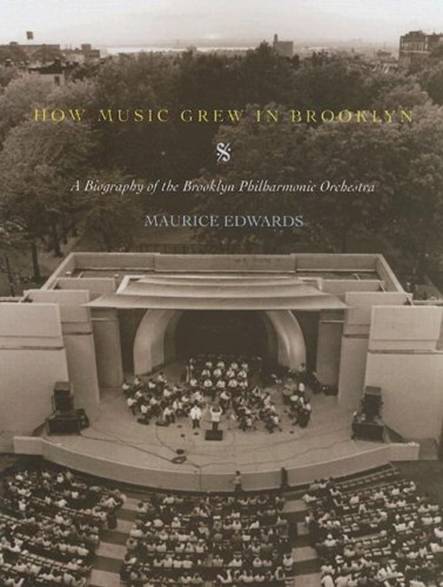|
IN REVIEW: ‘HOW MUSIC GREW IN BROOKLYN: A
BIOGRAPHY OF THE BROOKLYN PHILHARMONIC ORCHESTRA’ Maurice Edwards, Author |
|
|
Photo by Ken Howard The Brooklyn Philharmonic Orchestra performing in the
Prospect Park Bandshell. |
Lukas Foss:
A towering innovative figure of the modern musical age.
Lukas Foss:
Music Director and Conductor of the Brooklyn Philharmonic Orchestra, 1971 –
1990, at the podium. |
|
By Eve Berliner The rapturous sweep of
musical history has come to life inside the hallowed concert halls of the
Brooklyn Academy of Music, as captured by Maurice Edwards in his engrossing
new, meticulously documented, memoir, history, reminiscence and archival
treasure, “How Music Grew in Brooklyn: A Biography of the Brooklyn
Philharmonic Orchestra.” The book is at once an
intimate inside view and a reference work for musical and cultural scholars,
students and lovers of music. The orchestra had its
beginnings in 1857 (when Brooklyn was still a city) as the Philharmonic
Society of Brooklyn, the prodigy child of the new Brooklyn Academy of Music
which made its elegant new home on Montague Street in the burgeoning, rich,
Wall Street enclave of Brooklyn Heights, home to the orchestra. Under the baton of the renowned Theodore
Thomas, its conductor until 1891, the orchestra achieved notable
stature. In 1903 the building
went up in flames. And thus it moved to the
tree-lined elegance of Fort Greene Brooklyn, at 30 Lafayette Street, where it
resides today. The reign of the distinguished music director and conductor
Siegfried Landau [1955 to 1971] followed, and the renaissance brought to the
Brooklyn Academy of Music by Harvey Lichtenstein as its new director in 1967
placed it center stage on the New York cultural frontier. But it was The Era of
Foss, that would bring acclaim to the orchestra. Lukas Foss, an arresting
and brilliant conductor, a major 20th century composer, a
formidable pianist, was named music director and conductor of the Brooklyn
Philharmonia [as it was then known] in 1971, and proceeded to transform the
orchestra into a force to be reckoned with. It was an era of bold
innovation and profound artistic power, the two decade reign of Lukas Foss
over the Brooklyn Philharmonic Orchestra, molding an eclectic bunch of pick
up musicians into a virtuosic and powerful symphony orchestra. The Brooklyn Academy of
Music became a hot-bed of musical ferment as Foss explored new realms of
music and old symphonic masterpieces, the old war horses and the avant garde
suffusing the musical atmosphere around Brooklyn with vibrancy and
excitement. And they came, the
classical masters of the day: Yehudi
Menuhin, Aaron Copland, Leonard Bernstein, Itzhak Perlman, Loren Maazel,
Peter Serkin, Jessye Norman, Robert Merrill, Alicia de Larrocha, Loren
Hollander, James Galway, Victoria de Los Angeles, Roberta Peters, Claudio
Arrau, Richard Stolzman, Leonard Rose, Byron Janis, Lynn Harrell, Andre Watts
– the procession of greats drawn to the spotlight of BAM. New vibrant programs,
the brainstorm of Foss: Meet the Moderns, the Marathons, free summer parks
concerts, children’s concerts led by the great innovative David Amram. The
experimenters came, the visionaries, Foss himself, works by Steve Reich,
Charles Ives, Elliott Carter, Samuel Barber, Henry Cowell, Virgil Thomson,
William Schuman -- a stage to explore
and shock and improvise, a forum for new composers on the cusp, new sounds,
new musical adventures. Author Maurice Edwards,
who spent 40 years with the orchestra from the inception of the modern
Brooklyn Philharmonic in 1954, culminating in his role as both executive and
artistic director, tells the story from his own unique vantage point. The final ruthless
dumping of Foss in search of the elusive
younger audience, was followed by Dennis Russell Davies and Robert Spano
as music directors, the orchestra never quite recovering its majesty after
Foss’ departure. Read the book. It’s all there. |
|


